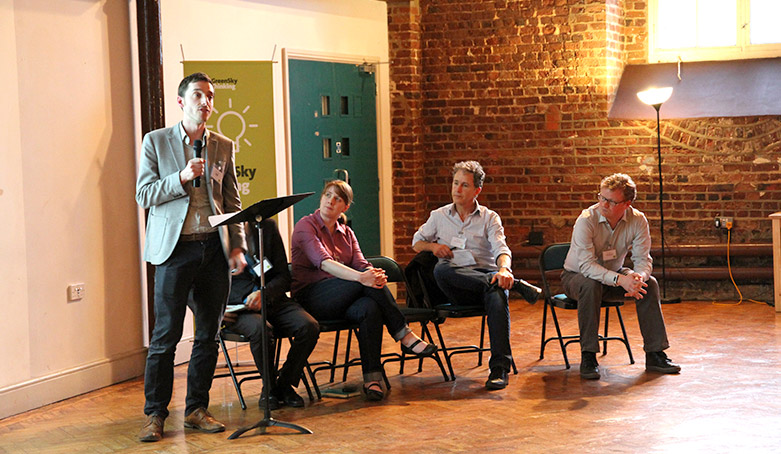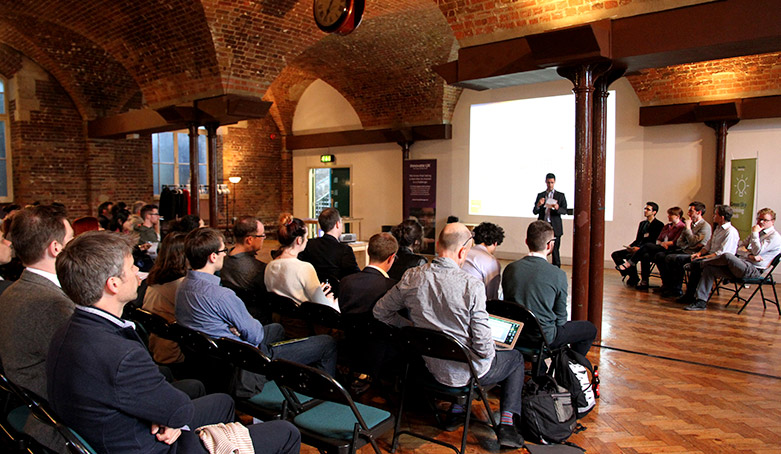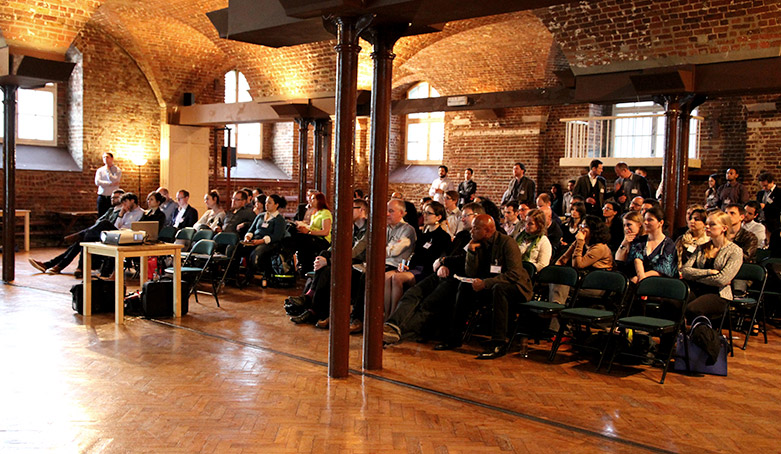In partnership with Innovate UK, XCO2 hosted an event titled ‘Continuous Improvement: Learning from the Latest Buildings Performance’. This event was part of the Open City Green Sky Thinking Week programme of discussions around sustainable and environmental buildings. Below is a very brief summary of the presentations, further details of all of the case studies discussed will be available through Innovate UK once they have amalgamated all of the data and findings collected.
Mat Colmer (Lead Technologist – Low Impact Building Innovation Platform for Innovate UK), chair for the event, introduced the evening. Presenting a background to the Innovate UK (formerly known as the Technology Strategy Board) Building Performance Evaluation (BPE) programme. Which included evaluating the performance of 101 developments in the domestic and non-domestic sectors. There was roughly an even split amongst these two sectors, as well as a good spread throughout the UK and a variety of building types (multi-residential, private residential, schools, office, hotels etc).
Mat presented an overview of some headline key findings of the scheme. Including, perhaps unsurprisingly, that energy consumption in reality is often much higher than was designed for. Other messages included observations on over-complicated systems, a focus at design stage on CO2 and energy targets, newer technologies in buildings are not fully understood, and that clients are not benefitting fully from the measures that they have paid for.
First up was Tassos Kougionis from the Zero Carbon Hub. Tassos presented a scheme he was involved in, which investigated the difference in energy performance between 2 sets of identical blocks of flats built to different energy standards. Lessons learnt from the project included that design and construction teams seemed unfamiliar with new construction techniques, and the handover and commissioning process was almost non-existent. However, contrary to Mat Colmer’s summary at the beginning, the in-use energy performance of the dwellings in this project were not far higher than predicted, and quite rightly this was seen as positive and better than could have been expected. In addition, generally occupant feedback was positive, with the exception of overheating. This overheating issue was further investigated as part of the study.
Marianne Heaslip from Urbed was next, talking about an igloo-funded building project located in Bermondsey Square, Manchester. This mixed-use development included a hotel, apartments, and offices; all of which were connected to a district heating system.
Once occupied, a key observation in the office was that most blinds were down. Overheating was also noted. It was evident that occupants were unable to open windows; a decision made during design for value engineering and acoustic considerations. Marianne clearly lamented these design decisions and, unfortunately, due to lack of cooling in the office space, air-conditioning systems had to be retrofitted into the building. Marianne concluded by mentioning that all issues had now been resolved in the building, however, only once a very good facility manager was appointed; highlighting the importance of this role to ensure good building performance.
XCO2’s very own Tom Kordel was third to present, focussing on the district heating performance gap. Using a residential apartment block as a case study, Tom described the gap between design and reality. Firstly, it was evident that the boilers were running 20% less efficiently than was predicted. Secondly, it was predicted that these boilers would be run entirely on biomass, however, unfortunately they were only being run on biomass for a third of the time. Lastly, the distribution losses in the system meant that an alarming 12 times more heat was being lost than was anticipated! All these problems meant that the CO2 factor for heat measured during operation of the scheme was 10 times larger than the initial design prediction.
Tom suggested some possible remedies to prevent the issues above from happening, including early client engagement, a need to stop value-engineering key parts of communal heating systems (metering and controls), and better metering strategies Tom also emphasised the industry to learn more about these systems, citing successful schemes in Denmark as perfect examples of best practice.
Last up for session one was Justin Bere, head of Passivhaus enthusiasts, Bere Architects.
Justin summarised the results of a private dwelling in Camden. Justin advised to ‘do your research’ before doing a first Passivhaus project, citing beneficial insight from German building physicists. Measured data on air tightness and co-heating seemed to be better than was expected. Justin recommended use of simple controls, and suggested closing the performance gap was not as difficult as we might have been lead to believe.
Starting off session 2 was Jesse Putzel from BAM Construction. Jesse’s presentation focussed on a school project in High Wycombe. Jesse described the merits and issues with the school. On one hand, the school was warmly received by the users, citing a popular school design. However, on the other, issues raised included complicated systems, much higher energy use, and issues with biomass stores and water ingress.
Jesse also highlighted how high environmental performance targets and a need to meet DfoE acoustic targets led to a strange mesh of low carbon technologies and a complex mechanical ventilation system. This led to complex build controls and subsequent problems with operating the building efficiently. . In conclusion, Jesse demonstrated how in more recent schools, BAM had learnt from this with simpler systems, intuitive user controls and careful handover in order to deliver better building performance with lower construction budgets.
Following Jesse was Judit Kimpian from AHR Architects. Judit mentioned a number of BPE schemes she had been involved with, and compared them using the CarbonBuzz online platform. Judit discussed some potential trends from this exercise, including the lack of correlation between energy consumption and occupant satisfaction. However, there seemed to be evidence of a strong correlation between the quality of health of an internal environment and an occupants’ satisfaction levels. Judit believes that good architecture is key to better energy performance.
Julie Godefroy from Hoare Lea was next, and talked in-depth about a luxury Hotel building project in Islington. Julie mentioned that Islington Council, well known for striving for better energy use in buildings, pushed the project team with regards to the energy hierarchy. Julie was entertainingly opinionated, being of the mind to completely disregard EPC ratings associated with buildings.
With regards to the hotel’s energy performance, a key finding was the overly excessive hot water use; far in excess of industry benchmarks. As was mentioned later in the presentation, customer feedback was very positive, highlighting the large bath as a great feature. While almost certainly answering the question of the high water use, it also highlighted the trade-off between having a luxury hotel, with all the associated features you may expect, and low energy use. Julie also had praise for the facility manager, citing him to be responsive, proactive and helping the study enormously through manual daily energy readings; as once again, meters were not installed and commissioned properly. It was soon realised that remediation and fine-tuning works in the hotel once in operation were very difficult; as they are 24/7 businesses.
Last, but by no means least, was Richard Partington from Richard Partington Architects. Richard’s presentation focussed on an office and community building for Greenfields Community Housing Association.
In a refreshingly honest presentation, Richard lamented his industry for over-complicating building design through use of pretty graphics and idealistic environmental strategy diagrams. The scheme itself suffered from issues with glare, and poor thermal comfort is due to difficulties with natural ventilation controls and user operation. Richard mentioned that there was an obvious communication gap with regards to the passive design strategies included in the design. And stressed that this could have been resolved by clear and simple explanations to the tenant.
In summary, the evenings’ presentations gave a wealth of building performance feedback to audience members and fellow speakers alike. It is clear the UK building industry still has a mountain to climb in reaching operational building energy performance excellence. However, in most cases, the findings are clearly identified through BPE activities like this BPE programme, and improve knowledge in the industry. The key, it seems, is to improve knowledge in the industry through BPE dissemination and apply these lessons learnt into future developments.
XCO2 would like to thank the speakers, Innovate UK and Open City for helping us to put on this event, which seems to have been very well received by all who attended.




